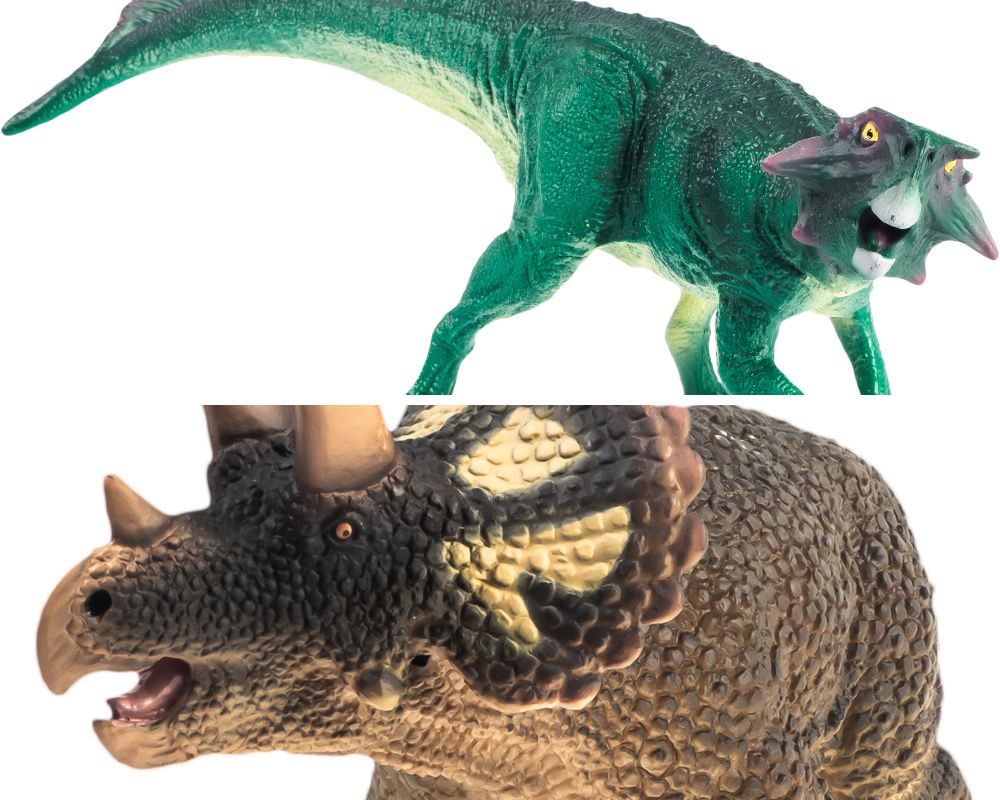The Psittacosaurus was a small Ceratopsian or horned dinosaur that lived in Asia. Psittacosaurus is named “Parrot Lizard” because of its parrot-like face. Hundreds of Psittacosaurus fossils have been found in Siberia, Russia, and Thailand.
Table of Contents
Some Quick Facts about the Psittacosaurus

| Name | Psittacosaurus (meaning “Parrot Lizard”) |
| Type of dinosaur | Basal (early) Ceratopsian Dinosaur |
| Territory | Dense forest with plenty of streams, Asia-Mongolia, Thailand, Russia, and Liaoning Province, Northeastern China |
| Size | About the size of an emu, 6-5 feet long, 4 feet tall |
| Color | Greenish |
| Interesting Characteristics | Bipedal with thick hind limbs, long tail, horn-like cheek spikes, and a head that looked like a parrot |
| Diet | Herbivore |
| Major Threats | Large predators, climate change, and natural disasters |
The Psittacosaurus is one of the most well-known dinosaurs in paleontology, and one of the most common of all dino fossils. Hundreds of fossil specimens of Psittacosaurus have helped us learn about more than just the Psittacosaurus. Thanks to Psittacosaurus fossil records, we know more about all dinosaurs throughout the Mesozoic Era.
How many species of Psittacosaurus are there?
As of 2019, there are 12 known species of Psittacosaurs. That makes the Psittacosaur dinosaur genus one of the largest ones.
Most dinosaur genera only have one or two species, but the taxonomy of Psittacosaurids is more complex than other groups.
When discussing all 12 species collectively, paleontology uses the abbreviation Psittacosaurus sp. Or “P.” instead of Psittacosaurus. The 12 known species of Psittacosaurus are:
- P. mongoliensis (Type species 1923)
- P. sinensis (1958)
- P. meileyingensis (1988)
- P. xinjiangensis (1988)
- P. sattayaraki (1992)
- P. neimongoliensis (1996)
- P. ordosensis (1996)
- P. mazongshanensis (1997)
- P. sibiricus (2000)
- P. lujiatunensis (2006)
- P. gobiensis (2010)
- P. amitabha (2019)
What kind of adaptations did the Psittacosaurus have?
The Psittacosaurus had several adaptations:
- Walked on four limbs when young
- Had tail bristles
- Likely had tails below the bristles
- Countershading
In addition to walking on four limbs as a baby and juvenile, Psittacosaurus had a few other interesting adaptations. The bristles on the tail are very similar to primitive feathers found in basal Archosaurs and Theropod dinosaurs.
At least one Psittacosaurus fossil appears to have feathers on its tail below the bristles. The presence of feathers, quills, bristles, or filaments suggests that earlier dinosaurs might have been covered with more than scales!
Countershading is another adaptation of the Psittacosaurus. Countershading is when different colors on the body help animals blend into the shadows, a type of camouflage. The Psittacosaurus’s belly was lighter in color, while the head and back were darker.
We’ve learned about this and other details about the Psittacosaurus from the specimen kept in the Senckenberg Museum in Germany.
Amazingly, the specimen of Psittacosaurus kept at Senckenberg is so well preserved that the countershading camouflage is visible, but there are also feathers on the tail and an intact cloaca! The cloaca is located at the base of the tail, where dinosaurs, reptiles, and birds release waste.
This discovery by paleontologists Kelly, Nicholls, and Vinther is the first of its kind. The Senckenberg Psittacosaurus fossil is also where paleontologists Bell, Sereno, and his team first saw the umbilical scar on a subadult Psittacosaurus.
Did Psittacosaurus have a belly button?
Because of preserved soft tissue found on subadult and juvenile Psittacosaurus specimens, we now know that dinosaurs had belly buttons.
The discovery of an umbilical scar or belly button on Psittacosaurus was amazing. Until this discovery in 2022, we had no idea that non-avian dinosaurs had belly buttons like modern-day vertebrate animals, including humans.
Psittacosaurus fossils have also taught us about how Psittacosaurid and similar dinos mature. About 200 juvenile Psittacosaurus fossils were found in the Yixian Formation.
Comparing these fossils to older specimens of Psittacosaurus, paleontologists Zhao, Xu, Sullivan, Sander, and Benton realized that the bipedal Psittacosaurus walked on four legs when they were young. Their forelimbs grew faster than their hind limbs, making walking on four legs faster and easier.
What did the Psittacosaurus eat?
The Psittacosaurus was a herbivore (like Saichania). It ate most of the available plants using its sharp beak. We know this because it had teeth at the rear end of its jaw but didn’t have molars. This is why it likely had to swallow stones to help it digest the food like parrots do today.
What Is the Difference Between a Psittacosaurus and a Triceratops?

| Psittacosaurids | Didn’t have a neck frill or the large horns |
| Triceratops | Had frills and horns, evolved from the blueprint of Psittacosaurus and another basal dino |
Psittacosaurids and Triceratops were Ceratopsian dinosaurs, a group of horned Ornithischian dinosaurs. Unlike Triceratops, Psittacosaurus didn’t have a neck frill or the large horns of later Ceratopsia. Psittacosaurus was a basal or early Ceratopsian.
Ceratopsian dinos like Triceratops evolved from the blueprint of Psittacosaurus and another basal dino. Later Ceratopsian dinos were bigger and had more impressive armor. Psittacosaurus did have horns, but they came out from its cheeks.
Instead of the thagomizer or spiked tail Triceratops was known for, Psittacosaurus had bristles halfway up its tail. Paleontologists have compared these bristles to the quill of the Tianyulong and discovered that the bristles went deep into the skin, almost to the tail bones!
So many Psittacosaurus fossils have been found that scientists can study them from hatchlings into adulthood. Paleontologists have even found a baby Psittacosaurus fossil in the stomach of a badger-like Cretaceous mammal called the Repenomamus.
The things scientists have learned about Psittacosaurs have helped them solve mysteries about dinosaurs from the Jurassic and Triassic Period, too. The Parrot Lizard Psittacosaurus is one of the most amazing dinos ever found.

